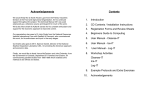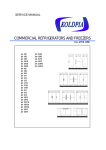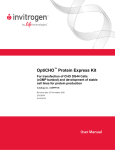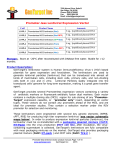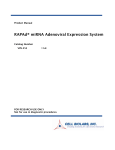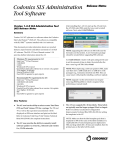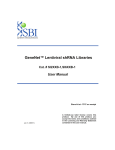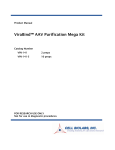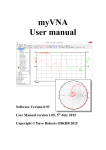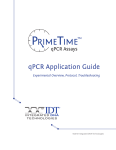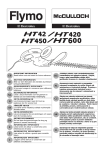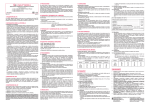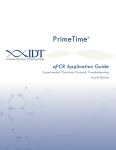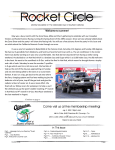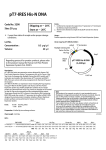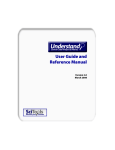Download Manual
Transcript
1 2 G1060 pFBAAVTREmcsBgHpA CMVrtTAwtIRESeGFPSV40pA Inducible miRNA Plasmid Plasmid Features: Coordinates 194-348 376-511 689-818 878-1193 1211-1274 1325-1538 1671-2193 2222-2974 2989-3575 1949-2668 2727-2863 2935-3053 3621-4154 4221-4445 5509-6369 Antibiotic Resistance: Ampicillin and Gentamicin Bacterial Backbone: pFastBac™ (Invitrogen) Feature Tn7L SV40pA (complementary-outside ITRs) AAV2 ITR (130bp) TRE promoter XhoI and XbaI MCS BgHpA CMV Promoter rtTA Tet On Transactivator wtIRES EGFP SV40pA AAV2 ITR (119bp) Gentamicin Tn7R B-lactamase (Ampicillin) Complementary Note: To check the integrity of the AAV ITR’s perform single restriction enzyme digestions with XmaI, BssHII, and MscI. This vector was designed with EGFP under the constitutive expression from the CMV promoter for tracking while the expression of the miRNA cassette can be inducibly driven by the tetracycline-regulated TRE promoter for RNA interference (RNAi) analysis in mammalian cells. BssHII (691) XmaI (717) XmaI (728) BssHII (776) MscI (794) EcoRI (872) XhoI (1211) pA 13 EcoRI (1244) 0b p IT XmaI (1256) R 600 TR E XbaI (1274) 90 0 SV 4 0 8 10 0 78 8 4 00 0 0 T3 n0 70L 0 0 0 H Bg 0 12 75 0 A m llin ci pi 72 00 pA 150 6600 CMV 2 100 AgeI (2208) PacI (2218) 0 54 i ic m 00 33 n 51 00 48101 09bp 4IT 50R0 42 00 SV 40pA 3900 eGFP 00 36 Red type indicates unique restriction site. XmaI (2966) SalI (2975) E t IR S a nt Ge 30 00 00 57 0 rtTA 2 4 00 2 70 0 0 600 R T n7 MscI (5887) 1800 690 0 0 6300 pFBAAVTREt-mcs-pA-CMV-rtTA-wtIRESeGFP-pA 8596bp w EcoRI (2983) MscI (3567) BssHII (4687) XmaI (4661) BssHII (4344) BssHII (4613) MscI (4599) 1 >G1060 pFBAAVTREmcsBgHpACMVrtTAwtIRESeGFPSV40pA CCATTCGCCATTCAGGCTGCAAATAAGCGTTGATATTCAGTCAATTACAAACATTAATAACGAAGAGATG ACAGAAAAATTTTCATTCTGTGACAGAGAAAAAGTAGCCGAAGATGACGGTTTGTCACATGGAGTTGGC AGGATGTTTGATTAAAAACATAACAGGAAGAAAAATGCCCCGCTGTGGGCGGACAAAATAGTTGGGAAC TGGGAGGGGTGGAAATGGAGTTTTTAAGGATTATTTAGGGAAGAGTGACAAAATAGATGGGAACTGGGT GTAGCGTCGTAAGCTAATACGAAAATTAAAAATGACAAAATAGTTTGGAACTAGATTTCACTTATCTGGTT CGGATCTCCTAGGCGATATCAGTGATCAGATCCAGACATGATAAGATACATTGATGAGTTTGGACAAACC ACAACTAGAATGCAGTGAAAAAAATGCTTTATTTGTGAAATTTGTGATGCTATTGCTTTATTTGTAACCATT ATAAGCTGCAATAAACAAGTTAACAACAACAATTGCATTCATTTTATGTTTCAGGTTCAGGGGGAGGTGT GGGAGGTTTTTTAAAGCAAGTAAAACCTCTACAAATGTGGTATGGCTGATTATGATCCTCTAGTACTTCTC GACAAGCTTACATTATTGAAGCATTTATCAGGGTTATTGTCTCAGACCTGCAGGCAGCTGCGCGCTCGCT CGCTCACTGAGGCCGCCCGGGCAAAGCCCGGGCGTCGGGCGACCTTTGGTCGCCCGGCCTCAGTGAGC GAGCGAGCGCGCAGAGAGGGAGTGGCCAACTCCATCACTAGGGGTTCCTTGTAGTTAATGATTAACCCG CCATGCTACTTATCTACGTAGCCATGCTCTAGTGAATTCCGAGTTTACTCCCTATCAGTGATAGAGAACGT ATGTCGAGTTTACTCCCTATCAGTGATAGAGAACGATGTCGAGTTTACTCCCTATCAGTGATAGAGAACG TATGTCGAGTTTACTCCCTATCAGTGATAGAGAACGTATGTCGAGTTTACTCCCTATCAGTGATAGAGAA CGTATGTCGAGTTTATCCCTATCAGTGATAGAGAACGTATGTCGAGTTTACTCCCTATCAGTGATAGAGA ACGTATGTCGAGGTAGGCGTGTACGGTGGGAGGCCTATATAAGCAGAGCTCGTTTAGTGAACCGTCAGA TCGCCAGATGGTACCGTTTAAACTCGAGGTCCACGGTATCGATAAGCTTGATATCGAATTCCTGCAGCCC GGGGGATCCACTAGTTCTAGAGCGAGCGCCACCGCGGACAGCGGGGAGATCCAGACATGATAAGATCC TCGACTGTGCCTTCTAGTTGCCAGCCATCTGTTGTTTGCCCCTCCCCCGTGCCTTCCTTGACCCTGGAAG GTGCCACTCCCACTGTCCTTTCCTAATAAAATGAGGAAATTGCATCGCATTGTCTGAGTAGGTGTCATTCT ATTCTGGGGGGTGGGGTGGGGCAGGACAGCAAGGGGGAGGATTGGGAAGACAATAGCAGGCATGCTG GGGAAGCCGGTCGCAGGCGTAGGGTAGGTTTGAGCAGATAAACCATTAAGTGATTAACAACGACGGCA CGAGCGGCCGCTTATTAATAGTAATCAATTACGGGGTCATTAGTTCATAGCCCATATATGGAGTTCCGCG TTACATAACTTACGGTAAATGGCCCGCCTGGCTGACCGCCCAACGACCCCCGCCCATTGACGTCAATAA TGACGTATGTTCCCATAGTAACGCCAATAGGGACTTTCCATTGACGTCAATGGGTGGAGTATTTACGGTA AACTGCCCACTTGGCAGTACATCAAGTGTATCATATGCCAAGTACGCCCCCTATTGACGTCAATGACGGT AAATGGCCCGCCTGGCATTATGCCCAGTACATGACCTTATGGGACTTTCCTACTTGGCAGTACATCTACG TATTAGTCATCGCTATTACCATGGTGATGCGGTTTTGGCAGTACATCAATGGGCGTGGATAGCGGTTTGA CTCACGGGGATTTCCAAGTCTCCACCCCATTGACGTCAATGGGAGTTTGTTTTGGCACCAAAATCAACGG GACTTTCCAAAATGTCGTAACAACTCCGCCCCATTGACGCAAATGGGCGGTAGGCGTGTACGGTGGGAG GTCTATATAAGCAGAGCTGGTTTAGTGAACCGTCAGATCCGCTAGCTACCGGTTTAATTAAGCCACCATG TCCAGACTGGACAAGAGCAAAGTCATAAACGGCGCTCTGGAATTACTCAATGGAGTCGGTATCGAAGGC CTGACGACAAGGAAACTCGCTCAAAAGCTGGGAGTTGAGCAGCCTACCCTGTACTGGCACGTGAAGAAC AAGCGGGCCCTGCTCGATGCCCTGCCAATCGAGATGCTGGACAGGCATCATACCCACTTCTGCCCCCTG GAAGGCGAGTCATGGCAAGACTTTCTGCGGAACAACGCCAAGTCATTCCGCTGTGCTCTCCTCTCACATC GCGACGGGGCTAAAGTGCATCTCGGCACCCGCCCAACAGAGAAACAGTACGAAACCCTGGAAAATCAG CTCGCGTTCCTGTGTCAGCAAGGCTTCTCCCTGGAGAACGCACTGTACGCTCTGTCCGCCGTGGGCCAC TTTACACTGGGCTGCGTATTGGAGGAACAGGAGCATCAAGTAGCAAAAGAGGAAAGAGAGACACCTAC CACCGATTCTATGCCCCCACTTCTGAGACAAGCAATTGAGCTGTTCGACCGGCAGGGAGCCGAACCTGC CTTCCTTTTCGGCCTGGAACTAATCATATGTGGCCTGGAGAAACAGCTAAAGTGCGAAAGCGGCGGGCC GGCCGACGCCCTTGACGATTTTGACTTAGACATGCTCCCAGCCGATGCCCTTGACGACTTTGACCTTGAT ATGCTGCCTGCTGACGCTCTTGACGATTTTGACCTTGACATGCTCCCCGGGTAAGTCGACTTGAATTCGC CCCTCTCCCTCCCCCCCCCCTAACGTTACTGGCCGAAGCCGCTTGGAATAAGGCCGGTGTGCGTTTGTCT ATATGTTATTTTCCACCATATTGCCGTCTTTTGGCAATGTGAGGGCCCGGAAACCTGGCCCTGTCTTCTTG ACGAGCATTCCTAGGGGTCTTTCCCCTCTCGCCAAAGGAATGCAAGGTCTGTTGAATGTCGTGAAGGAA GCAGTTCCTCTGGAAGCTTCTTGAAGACAAACAACGTCTGTAGCGACCCTTTGCAGGCAGCGGAACCCC CCACCTGGCGACAGGTGCCTCTGCGGCCAAAAGCCACGTGTATAAGATACACCTGCAAAGGCGGCACA ACCCCAGTGCCACGTTGTGAGTTGGATAGTTGTGGAAAGAGTCAAATGGCTCTCCTCAAGCGTATTCAAC AAGGGGCTGAAGGATGCCCAGAAGGTACCCCATTGTATGGGATCTGATCTGGGGCCTCGGTACACATGC TTTACATGTGTTTAGTCGAGGTTAAAAAACGTCTAGGCCCCCCGAACCACGGGGACGTGGTTTTCCTTTG AAAAACACGATGATAATATGGCCACAACCATGGTGAGCAAGGGCGAGGAGCTGTTCACCGGGGTGGTG CCCATCCTGGTCGAGCTGGACGGCGACGTAAACGGCCACAAGTTCAGCGTGTCCGGCGAGGGCGAGGG CGATGCCACCTACGGCAAGCTGACCCTGAAGTTCATCTGCACCACCGGCAAGCTGCCCGTGCCCTGGCC CACCCTCGTGACCACCCTGACCTACGGCGTGCAGTGCTTCAGCCGCTACCCCGACCACATGAAGCAGCA CGACTTCTTCAAGTCCGCCATGCCCGAAGGCTACGTCCAGGAGCGCACCATCTTCTTCAAGGACGACGG CAACTACAAGACCCGCGCCGAGGTGAAGTTCGAGGGCGACACCCTGGTGAACCGCATCGAGCTGAAGG GCATCGACTTCAAGGAGGACGGCAACATCCTGGGGCACAAGCTGGAGTACAACTACAACAGCCACAAC GTCTATATCATGGCCGACAAGCAGAAGAACGGCATCAAGGTGAACTTCAAGATCCGCCACAACATCGAG 2 GACGGCAGCGTGCAGCTCGCCGACCACTACCAGCAGAACACCCCCATCGGCGACGGCCCCGTGCTGCT GCCCGACAACCACTACCTGAGCACCCAGTCCGCCCTGAGCAAAGACCCCAACGAGAAGCGCGATCACA TGGTCCTGCTGGAGTTCGTGACCGCCGCCGGGATCACTCTCGGCATGGACGAGCTGTACAAGTAAATCG ATTTACGCGTGAGCTCCAATTCGCCCTATAGTGAGTCGTATTACGCGCGCAGCGGCCGACCATGGCCCA ACTTGTTTATTGCAGCTTATAATGGTTACAAATAAAGCAATAGCATCACAAATTTCACAAATAAAGCATTT TTTTCACTGCATTCTAGTTGTGGTTTGTCCAAACTCATCAATGTATCTTATCATGTCTGGATCTCCGGACAC GTGCGGACCGAACTAGAGCATGGCTACGTAGATAAGTAGCATGGCGGGTTAATCATTAACTACAAGGAA CCCCTAGTGATGGAGTTGGCCACTCCCTCTCTGCGCGCTCGCTCGCTCACTGAGGCCGGGCGACCAAAG GTCGCCCGACGCCCGGGCGGCCTCAGTGAGCGAGCGAGCGCGCAGCTGCCTGCAGGCATGCAAGCTGT AGCCAACCACTAGAACTATAGCTAGAGTCCTGGGCGAACAAACGATGCTCGCCTTCCAGAAAACCGAGG ATGCGAACCACTTCATCCGGGGTCAGCACCACCGGCAAGCGCCGCGACGGCCGAGGTCTTCCGATCTC CTGAAGCCAGGGCAGATCCGTGCACAGCACCTTGCCGTAGAAGAACAGCAAGGCCGCCAATGCCTGAC GATGCGTGGAGACCGAAACCTTGCGCTCGTTCGCCAGCCAGGACAGAAATGCCTCGACTTCGCTGCTGC CCAAGGTTGCCGGGTGACGCACACCGTGGAAACGGATGAAGGCACGAACCCAGTTGACATAAGCCTGT TCGGTTCGTAAACTGTAATGCAAGTAGCGTATGCGCTCACGCAACTGGTCCAGAACCTTGACCGAACGC AGCGGTGGTAACGGCGCAGTGGCGGTTTTCATGGCTTGTTATGACTGTTTTTTTGTACAGTCTATGCCTCG GGCATCCAAGCAGCAAGCGCGTTACGCCGTGGGTCGATGTTTGATGTTATGGAGCAGCAACGATGTTAC GCAGCAGCAACGATGTTACGCAGCAGGGCAGTCGCCCTAAAACAAAGTTAGGTGGCTCAAGTATGGGC ATCATTCGCACATGTAGGCTCGGCCCTGACCAAGTCAAATCCATGCGGGCTGCTCTTGATCTTTTCGGTC GTGAGTTCGGAGACGTAGCCACCTACTCCCAACATCAGCCGGACTCCGATTACCTCGGGAACTTGCTCC GTAGTAAGACATTCATCGCGCTTGCTGCCTTCGACCAAGAAGCGGTTGTTGGCGCTCTCGCGGCTTACGT TCTGCCCAAGTTTGAGCAGCCGCGTAGTGAGATCTATATCTATGATCTCGCAGTCTCCGGCGAGCACCG GAGGCAGGGCATTGCCACCGCGCTCATCAATCTCCTCAAGCATGAGGCCAACGCGCTTGGTGCTTATGT GATCTACGTGCAAGCAGATTACGGTGACGATCCCGCAGTGGCTCTCTATACAAAGTTGGGCATACGGGA AGAAGTGATGCACTTTGATATCGACCCAAGTACCGCCACCTAACAATTCGTTCAAGCCGAGATCGGCTTC CCGGCCGCGGAGTTGTTCGGTAAATTGTCACAACGCCGCGAATATAGTCTTTACCATGCCCTTGGCCACG CCCCTCTTTAATACGACGGGCAATTTGCACTTCAGAAAATGAAGAGTTTGCTTTAGCCATAACAAAAGTC CAGTATGCTTTTTCACAGCATAACTGGACTGATTTCAGTTTACAACTATTCTGTCTAGTTTAAGACTTTATT GTCATAGTTTAGATCTATTTTGTTCAGTTTAAGACTTTATTGTCCGCCCACACCCGCTTACGCAGGGCATC CATTTATTACTCAACCGTAACCGATTTTGCCAGGTTACGCGGCTGGTCTATGCGGTGTGAAATACCGCAC AGATGCGTAAGGAGAAAATACCGCATCAGGCGCTCTTCCGCTTCCTCGCTCACTGACTCGCTGCGCTCG GTCGTTCGGCTGCGGCGAGCGGTATCAGCTCACTCAAAGGCGGTAATACGGTTATCCACAGAATCAGGG GATAACGCAGGAAAGAACATGTGAGCAAAAGGCCAGCAAAAGGCCAGGAACCGTAAAAAGGCCGCGTT GCTGGCGTTTTTCCATAGGCTCCGCCCCCCTGACGAGCATCACAAAAATCGACGCTCAAGTCAGAGGTG GCGAAACCCGACAGGACTATAAAGATACCAGGCGTTTCCCCCTGGAAGCTCCCTCGTGCGCTCTCCTGT TCCGACCCTGCCGCTTACCGGATACCTGTCCGCCTTTCTCCCTTCGGGAAGCGTGGCGCTTTCTCATAGC TCACGCTGTAGGTATCTCAGTTCGGTGTAGGTCGTTCGCTCCAAGCTGGGCTGTGTGCACGAACCCCCC GTTCAGCCCGACCGCTGCGCCTTATCCGGTAACTATCGTCTTGAGTCCAACCCGGTAAGACACGACTTAT CGCCACTGGCAGCAGCCACTGGTAACAGGATTAGCAGAGCGAGGTATGTAGGCGGTGCTACAGAGTTCT TGAAGTGGTGGCCTAACTACGGCTACACTAGAAGAACAGTATTTGGTATCTGCGCTCTGCTGAAGCCAGT TACCTTCGGAAAAAGAGTTGGTAGCTCTTGATCCGGCAAACAAACCACCGCTGGTAGCGGTGGTTTTTTT GTTTGCAAGCAGCAGATTACGCGCAGAAAAAAAGGATCTCAAGAAGATCCTTTGATCTTTTCTACGGGGT CTGACGCTCAGTGGAACGAAAACTCACGTTAAGGGATTTTGGTCATGAGATTATCAAAAAGGATCTTCAC CTAGATCCTTTTAAATTAAAAATGAAGTTTTAAATCAATCTAAAGTATATATGAGTAAACTTGGTCTGACA GTTACCAATGCTTAATCAGTGAGGCACCTATCTCAGCGATCTGTCTATTTCGTTCATCCATAGTTGCCTGA CTCCCCGTCGTGTAGATAACTACGATACGGGAGGGCTTACCATCTGGCCCCAGTGCTGCAATGATACCG CGAGACCCACGCTCACCGGCTCCAGATTTATCAGCAATAAACCAGCCAGCCGGAAGGGCCGAGCGCAG AAGTGGTCCTGCAACTTTATCCGCCTCCATCCAGTCTATTAATTGTTGCCGGGAAGCTAGAGTAAGTAGT TCGCCAGTTAATAGTTTGCGCAACGTTGTTGCCATTGCTACAGGCATCGTGGTGTCACGCTCGTCGTTTG GTATGGCTTCATTCAGCTCCGGTTCCCAACGATCAAGGCGAGTTACATGATCCCCCATGTTGTGCAAAAA AGCGGTTAGCTCCTTCGGTCCTCCGATCGTTGTCAGAAGTAAGTTGGCCGCAGTGTTATCACTCATGGTT ATGGCAGCACTGCATAATTCTCTTACTGTCATGCCATCCGTAAGATGCTTTTCTGTGACTGGTGAGTACTC AACCAAGTCATTCTGAGAATAGTGTATGCGGCGACCGAGTTGCTCTTGCCCGGCGTCAATACGGGATAA TACCGCGCCACATAGCAGAACTTTAAAAGTGCTCATCATTGGAAAACGTTCTTCGGGGCGAAAACTCTCA AGGATCTTACCGCTGTTGAGATCCAGTTCGATGTAACCCACTCGTGCACCCAACTGATCTTCAGCATCTTT TACTTTCACCAGCGTTTCTGGGTGAGCAAAAACAGGAAGGCAAAATGCCGCAAAAAAGGGAATAAGGG CGACACGGAAATGTTGAATACTCATACTCTTCCTTTTTCAATATTATTGAAGCATTTATCAGGGTTATTGTC TCATGAGCGGATACATATTTGAATGTATTTAGAAAAATAAACAAATAGGGGTTCCGCGCACATTTCCCCG AAAAGTGCCACCTAAATTGTAAGCGTTAATATTTTGTTAAAATTCGCGTTAAATTTTTGTTAAATCAGCTCA TTTTTTAACCAATAGGCCGAAATCGGCAAAATCCCTTATAAATCAAAAGAATAGACCGAGATAGGGTTGA 3 GTGTTGTTCCAGTTTGGAACAAGAGTCCACTATTAAGAACGTGGACTCCAACGTCAAAGGGCGAAAAAC CGTCTATCAGGGCGATGGCCCACTACGTGAACCATCACCCTAATCAAGTTTTTTGGGGTCGAGGTGCCGT AAAGCACTAAATCGGAACCCTAAAGGGAGCCCCCGATTTAGAGCTTGACGGGGAAAGCCGGCGAACGT GGCGAGAAAGGAAGGGAAGAAAGCGAAAGGAGCGGGCGCTAGGGCGCTGGCAAGTGTAGCGGTCACG CTGCGCGTAACCACCACACCCGCCGCGCTTAATGCGCCGCTACAGGGCGCGTC Plasmid Quality Control Transfection: Plasmid Quality Control ITR Digest: G1060 pFBAAVTREmcsBgHpACMVrtTAwtIRESeGFPSV40pA Midi Prep date: 7/9/14 Concentration: 2.4ug/ul Uncut BssHII MscI XmaI Expected Fragments from digest of insertless plasmid: 4000- 2000- Uncut: supercoiled and relaxed. BssHII: 4600, 3568, 269, 85, 74 MscI: 3503, 2773, 1288, 1032 XmaI: 4652, 1710, 1695, 528, 11 16501000- 500- 4 Specific Information for cloning miRNA in the G1060 pFBAAVTREmcsBgHpACMVrtTAwtIRESeGFPSV40pA Plasmid: _________________________________________________________________________________________________ Background: This vector was designed with two independent cassettes. 1. TRE-miRNA-BgHpA and 2. CMV-rtTA-wtIRESeGFP-SV40pA. The dox inducible, tetracycline-regulated TRE promoter drives the miRNA cassette. Constitutive expression from the CMV promoter drives the rtTA transactivator and the expression of eGFP for tracking. In the absence of induction according to the originator Clonetech, the Tet-On Advanced transactivator shows virtually no residual binding to the TRE in PTight. Thus, basal expression is extremely low. Please refer to the original Clonetech guides for useful information on working with the Tet-On Advanced System. Please note that this plasmid was designed by customer request in 2014 and the University of Iowa Viral Vector Core has limited experience with inducible miRNA. For constituitively driven miRNA, please see plasmids G0760 pFBAAVmU6mcsCMVeGFP or G0774 pFBAAVmU6mcsCMVmCherry. Tet-On Advanced Inducible Gene Expression Systems User Manual #PT3898-1_102312-7 http://www.google.com/url?sa=t&rct=j&q=&esrc=s&source=web&cd=7&ved=0CGcQFjAG&url=http%3A%2F%2Fwww.clonte ch.com%2Fxxclt_ibcGetAttachment.jsp%3FcItemId%3D17561&ei=3LupU6jCJsWfqAbksILoCA&usg=AFQjCNEQOJMoyr4O PqqXaaOPcwNbudctcA&bvm=bv.69620078,d.b2k Mir-XTM Inducible miRNA Systems User Manual #PT5050-1 http://www.google.com/url?sa=t&rct=j&q=&esrc=s&source=web&cd=1&ved=0CCIQFjAA&url=http%3A%2F%2Fwww.clontec h.com%2Fxxclt_ibcGetAttachment.jsp%3FcItemId%3D17566&ei=rMCpU8ftB9KXqAb4mYGAAg&usg=AFQjCNGqfljnWOPOihXdi0Q0VTfaHbdVw&bvm=bv.69620078,d.b2k References: Generation of hairpin-based RNAi vectors for biological and therapeutic application. Boudreau RL, Davidson BL. Methods Enzymol. 2012;507:275-96. Review. PMID: 22365779 [PubMed - indexed for MEDLINE] http://www.sciencedirect.com/science/article/pii/B9780123865090000144 siSPOTR: a tool for designing highly specific and potent siRNAs for human and mouse. Boudreau RL, Spengler RM, Hylock RH, Kusenda BJ, Davis HA, Eichmann DA, Davidson BL. Nucleic Acids Res. 2012 Aug 31. [Epub ahead of print] PMID: 22941647 [PubMed - as supplied by publisher] siSPOTR (siRNA Sequence Probability-of-Off-Targeting Reduction) https://sispotr.icts.uiowa.edu/sispotr/index.html;jsessionid=E8EB7B91C5640FD84F7E72DC758505DD Rational design of therapeutic siRNAs: minimizing off-targeting potential to improve the safety of RNAi therapy for Huntington's disease. Boudreau RL, Spengler RM, Davidson BL. Mol Ther. 2011 Dec;19(12):2169-77. doi: 10.1038/mt.2011.185. Epub 2011 Sep 27. Plasmid-based RNA interference: Construction of small-hairpin RNA (shRNA) expression vectors. Harper SQ, Davidson BL. Methods Mol Biol 309:219-235, 2005. Translational efficiency of EMCV IRES in bicistronic vectors is dependent on IRES sequence and gene location. Yury A. Bochkov and Ann C. Palmenberg. BioTechniques 41:283-292, 2006. ___________________________________________________________________________________________________ Protocol: Below are revised excerpts from Generation of hairpin-based RNAi vectors for biological and therapeutic application for miRNA design and cloning. Section numbers refer to the numbers in the original publication. 5 GENERATION OF HAIRPIN-BASED RNAi VECTORS FOR BIOLOGICAL AND THERAPEUTIC APPLICATION Ryan L. Boudreau and Beverly Davidson Contents 2. Selecting Candidate siRNA Sequences 2.1. Retrieve sequences for your desired target transcript(s) 2.2. Select 22-nt long target sites 4. Cloning Artificial miRNA Expression Vectors 4.1. Considerations for designing artificial miRNAs 4.2. Oligo design and cloning protocol for artificial miRNAs 2. Selecting Candidate siRNA Sequences 2.1. Retrieve sequences for your desired target transcript(s) Choose your target gene(s) of interest and retrieve the relevant mRNA sequence(s) from NCBI, Ensembl, UCSC Genome Browser, or other available databases. We leave it to the reader's responsibility to further investigate target transcripts for variants which may result from RNA processing events (e.g., alternative splicing, alternative polyadenylation, and RNA editing, among others) that may influence the ability to target certain regions within the transcript. In general, we target the coding region; however, targeting the 5′- and 3′-UTR sequences is possible. Careful consideration for the target sequence with regard to the project objectives is important before proceeding with design and screening of inhibitory RNA sequences. For instance, the reader should consider whether allele- or splice-isoform-specific silencing is desirable or whether sequence conservation is important, allowing the RNAi vectors to be tested in multiple species. 2.2. Select 22-nt long target sites Identifying potent and highly specific siRNA sequences is not trivial. Numerous empirical evaluations of large-scale siRNA knockdown data have allowed researchers to establish several siRNA design guidelines (Khvorova et al., 2003; Matveeva et al., 2007). For example, one key consideration is that siRNA sequences be selected or manipulated to promote accurate loading of the antisense guide strand into RISC, leaving the sense strand to be degraded (Leuschner et al., 2006; Matranga et al., 2005). Furthermore, GC-content and positional nucleotide preferences also influence siRNA efficacy. Given the multifaceted nature of designing optimal siRNAs, we direct the reader to additional literature on the subject (Birmingham et al., 2007; Davidson and McCray, 2011; Jackson and Linsley, 2010). Also, there are numerous publicly available siRNA design tools online. It is important to note that siRNA design rules serve more as guidelines, and that sequences adhering to them may not silence and vice versa. NEW: We have developed an online tool, siSPOTR (siRNA Seed Probability of Off-Target Reduction) to assist users with 1 designing siRNAs with low off-targeting potential (https://research.icts.uiowa.edu/sispotr_review2011/) . siSPOTR searches user-defined target sequences for siRNAs that pass strand-biasing and GC% filters and outputs the candidates with the lowest POTS values. The output provides detailed off-target information for each siRNA including i) the number of 3’-UTRs containing each seed site type, ii) the putative off-target transcripts, and iii) counts of each seed site type on a per transcript basis. siSPOTR also determines if the siRNA seed matches that of a known miRNA. Recognizing the ease of purchasing pre-validated siRNAs, an additional tool allows users to input siRNA sequences to obtain relevant off-targeting scores and information. https://sispotr.icts.uiowa.edu/sispotr/index.html;jsessionid=E8EB7B91C5640FD84F7E72DC758505DD To date, no algorithm guarantees silencing efficacy, and it is most recommend that the user pick three to four candidates for screening. Some investigators screen 10-20 candidates at a time. Tips and short cuts for working with multiple candidates are outlined in the cloning information below. Here, we will describe a basic strategy for siRNA target site selection which incorporates the most important criteria for promoting efficacy, in addition to certain rules that are specific to the design of hairpin-based RNAi expression vectors. We identify 22-nt target sites within the target transcript that adhere to four criteria: (1) high propensity to primarily load the antisense guide strand into RISC, (2) GC content between 20% and 70%, (3) void of restriction enzyme sites relevant to downstream applications (e.g., cloning RNAi expression cassettes into viral vector systems), (4) lacking a stretch of four continuous A or T nucleotides (i.e., AAAA or TTTT). The latter prevents premature transcription termination from Pol III promoters which typically terminate at stretches of four to six T's. Strand biasing is determined by the thermodynamic stabilities present at the ends of the siRNA duplex. To achieve faithful loading of the antisense strand, the duplex must be designed such that there is strong G–C base pairing present at the 5′-end of the sense (passenger) strand and weak A/G-U base paring at the opposing terminus (Khvorova et al., 2003; Schwarz et al., 2003). The RISC complex selects the strand with the weakest 5′-end thermodynamic stability, in this case, the antisense strand (Fig. 14.1). Hence, we select target sequences that have G or C nucleotides at positions 3 and 4 (note: positions 1 and 2 correspond to the dinucleotide 3′overhang of the antisense strand) and A, T, or C nucleotides at positions 20, 21, and 22. The C is allowed at the latter positions because we can destabilize the resulting G–C base pairs by converting them to G–U base pairs (G and U weakly pair in RNA) without altering the antisense strand sequence. Next, the GC content of the 22-nt site is calculated by dividing 6 the number of G or C nucleotides by 22. For instance, the target site shown in Fig. 14.1 has 12 G or C nucleotides, resulting in a GC content of 55% which is within the acceptable range. Finally, we avoid stretches of A's and T's and relevant restriction enzyme sites for reasons mentioned above. Note: the user must also avoid creating these elements upon incorporating the siRNA into shRNA or artificial miRNA scaffolds. 4. Cloning Artificial miRNA Expression Vectors 4.1. Considerations for designing artificial miRNAs Artificial miRNAs, or miRNA shuttles, are designed to mimic naturally occurring pri-miRNAs, for which the Drosha-DGCR8 and Dicer cleavage sites have been mapped and experimentally validated. With this information, the identity of the small RNA duplex which is processed from the initial stem-loop transcript is known. For artificial miRNAs, this region is replaced by siRNA duplexes, thus creating a miRNA-based hairpin which serves to shuttle siRNA sequences into the RNAi pathway. An important consideration for designing artificial miRNAs is to maintain the structural and sequence recognition motifs required for appropriate processing. Drosha-DGCR8 binds to regions of single-stranded nature located at the base of the pri-miRNA stem loop (Han et al., 2004; Zeng and Cullen, 2005). Thus, including 50–100 nts of the flanking sequences (5′ and 3′) native to the pri-miRNA will help to ensure that the stem-loop base folds properly to promote cleavage at the intended site. Artificial miRNAs have been generated using a number of naturally occurring pri-miRNAs as scaffolds for siRNA sequences (Chung et al., 2006; Tsou et al., 2011; Zeng et al., 2002). Here, we will describe a method to generate artificial miRNAs based on the natural human miR-30 pri-miRNA transcript. For ease of cloning, we only include a minimal amount of natural miR-30 flanking sequences, while additional 5′- and 3′-sequences are derived from the mouse U6 expression vector. We have characterized these vectors for appropriate expression and processing using small transcript northern blot, small RNA RTPCR and RACE analyses (Boudreau et al., 2008; Chen et al., 2005). We recommend that newly designed miRNA shuttles be similarly defined with these techniques, since simply switching promoters, restriction enzyme sites, or expression contexts (e.g., embedding the miRNA-based stem loop in the 3′-UTR or intron of a reporter gene) can alter the pri-miRNA structure and subsequent processing. 4.2. Oligo design and cloning protocol for artificial miRNAs The following steps are outlined in Fig. 14.3. 7 Figure 14.3. Artificial miRNA cloning scheme. The details for designing artificial miRNAs and cloning them into the mU6 expression vector are described in the text (Section 4.2, Steps 1–8). Shown here is the example of incorporating the eGFPtargeted siRNA into an artificial miRNA scaffold. How to use the siSPOTR tool: • • • • • • Input sequence(s) for siRNA design at https://sispotr.icts.uiowa.edu/sispotr/tools/sispotr/design.html Click the appropriate button to paste or upload the sequence(s). Single sequences can be in plain or FASTA format. Multiple sequences require FASTA formatting. Select the number of candidates desired in the output. (Advanced) Modify input parameters: GC Content (%Min/Max): Filters candidate sequences based on specified GC content range. 5' Passenger G/C Number: Forces the passenger strand to have high 5' end stability. This decreases likelihood of loading the unintended (passenger) strand. Additional parameters to promote guide strand loading are automatically included in the design. Pol III Expression: Removes sequences with ≥4 T/U's. Stretches of 4 or more U's can serve as a termination 8 signal for RNA Pol III. Since many shRNA/artificial miRNA expression vectors use Pol III promoters (e.g. U6, H1) to drive expression, these sequences should be avoided to prevent pre-mature transcript termination. Run siSPOTR Browse additional off-target information (Highly Recommended): Click "Off-Target Details" to: BLAST against transcript databases. View the overall number of off-targets and the distribution of more potent seed sitetypes (7mer-1A, 7mer-M8, 8mer) View/download list of all predicted off-targets with site-type information. Additional considerations: siRNA sequences with POTS numbers less than 50 generally show less toxic effects. We suggest that you avoid sequences within 30 base pairs of a start or stop codon. When possible, you choose sequences with the lowest G/C content. • • • • Below is a step-by-step example incorporating the siSPOTR output and the steps listed in figure 14.3 above to create the miRNA primers. Example of siSPOTR output: rank Start position POTS percentile_worse siRNA_Seq (antisense) passenger_strand_seq (sense) 7Mer 8 75 23 92.60% UUAGCGCAGUCCUGGCUGCAU GCAGCCAGGACUGCGCUAANN UAGCGCA G/C content 61.9%-‐ 9.73 Step 1. Start with the artificial miRNA backbone sequence. The miR-30-based artificial miRNA backbone consists of constant regions that are partially derived from the human miR-30 pri-miRNA. DNA CTCGAGTGAGCG_____________ CTGTAAAGCCACAGATGGG_____________CGCCTACTAGT 5′ flanking (XhoI and linker) 19nt loop 3’ flanking (linker and SpeI) RNA CUCGAGUGAGCG_____________ CUGUAAAGCCACAGAUGGG_____________CGCCUACUAGU 5′ flanking (XhoI and linker) 19nt loop 3’ flanking (linker and SpeI The backbone is engineered with flanking restriction enzyme sites for cloning purposes. The 5′-XhoI and 3′-SpeI sites were chosen since their respective GAG and ACT nucleotides correspond to natural miR-30 stem-loop sequences. The distal (relative to the loop) single nucleotide bulge pictured in Fig. 14.1 is formed by the 5′-and 3′-flanks, while the proximal bulge consists of the 3′-end of the antisense strand; thus, the opposing nucleotide must be manipulated to maintain the bulge for proper Drosha-DGCR8 processing (see Step 3 below). Step 2. Insert sense and antisense sequences. Insert the sense sequence (i.e., target site positions 1–22) immediately after the 5′flank sequence and the antisense sequence (i.e., the reverse complement of the target site) directly after the loop sequence. CUCGAGUGAGCGGCAGCCAGGACUGCGCUAANNCUGUAAAGCCACAGAUGGGUUAGCGCAGUCCUGGCUGCAUCGCCUACUAGU Step 2.1. Delete N’s and add a and matched u on either side of the 19nt loop. 20nt 22nt CUCGAGUGAGCGGCAGCCAGGACUGCGCUAAaCUGUAAAGCCACAGAUGGGuUUAGCGCAGUCCUGGCUGCAUCGCCUACUAGU 9 Step 3. Add to 20nt to equal 22nt. Match inside base pair on 20nt to complement corresponding bp in 22nt. Manipulate the 5′-bulge nucleotide to induce a mismatch. The bulge is natural to the human miR-30 pri-miRNA transcript, and thus, we aim to maintain this structure to promote proper downstream cleavage by Drosha-DGCR8. In the example, the G nucleotide in the sense strand bulge position (5′) is converted to an A nucleotide which will create a mismatch with the opposing C bulge nucleotide in the antisense region (3′). In generating artificial miRNAs harboring different siRNA sequences, the user should alter the 5′-bulge nucleotide so that it does not pair with the opposing 3′-bulge nucleotide. This can be done following these simple guidelines: A: if the 3′-bulge site is an A, the 5′-bulge nucleotide can be changed from T to either C, G, or A. C: if the 3′-bulge site is a C, the 5′-bulge nucleotide can be changed from G to either A, T, or C. G: if the 3′-bulge site is a G, the 5′-bulge nucleotide can be changed from C to either A or G. T: if the 3′ bulge site is a T, the 5′-bulge nucleotide can be changed from A to either C or T. 20nt 22nt CUCGAGUGAGCG cUGCAGCCAGGACUGCGCUAAaCUGUAAAGCCACAGAUGGGuUUAGCGCAGUCCUGGCUGCAUCGCCUACUAGU Step 4. Convert C's to T's at the sense 3′-end to impart duplex instability. See Step 2 in shRNA cloning protocol (Section 3.2).Note: at this point, it is good practice to ensure the hairpin sequence is void of stretches of four or more T's and any restriction enzyme sites (e.g., internal XhoI, SpeI, and EcoRI sites) relevant to downstream applications. Step 5. Convert all T's to U's, if not already complete, and fold RNA using UNAfold. available at http://www.idtdna.com/Scitools/Applications/unafold/) to confirm that the miRNA transcript forms the desired secondary structure. Note: select “RNA” as the input “nucleotide type” at the user interface and leave the remaining parameters set to Predicted Dicer Cut Sites Instability Promotes AS in RISC Stability Promotes AS into RISC and keeps S out of RISC Predicted Drosha Cut sites default. UNAfold generally predicts several possible secondary structures for each input; however, the correct version of the miRNA should be at the top as the most stable structure. In this case, the fold should resemble the artificial miRNA depicted here. Extra bulges indicate that revisions are needed. Step 6. Convert all U’s to T’s. Design and order DNA oligos. The artificial miRNA DNA template is made by annealing two oligos that overlap in the loop region and performing a polymerase extension reaction to create the double-stranded DNA cassette. Oligo 1 consists of the XhoI site, 5′-flank, sense sequence, and loop in forward orientation, while Oligo 2 is the reverse complement of the loop, antisense, 3′-flank and SpeI site. We add four A nucleotides to the 5′-end of each oligo; thus, Oligo 1 will begin with 5′-AAAACTCGAG…-3′ and Oligo 2 with 5′-AAAAACTAGT…-3′. These additional bases are required for 10 efficient restriction enzyme digestion near the ends of the DNA cassette following the polymerase extension. The resulting DNA oligos can be ordered at reasonable cost from a variety of commercial vendors (e.g., Integrated DNA Technologies, Sigma-Aldrich, or Invitrogen) using the smallest synthesis scale available and standard desalting purification. Upon receipt, the oligos can be reconstituted in purified water to make a 100-μM stock. Hairpin 86mer CTCGAGTGAGCGcTGCAGCCAGGACTGCGCTAAaCTGTAAAGCCACAGATGGGtTTAGCGCAGTCCTGGCTGCATCGCCTACTAGT Hairpin-broken into two primers to be annealed and extended: (Random A’s added to the ends for digest) Oligo 1 miRNA For: 5’ AAAACTCGAGTGAGCGcTGCAGCCAGGACTGCGCTAAaCTGTAAAGCCACAGATGGG 3’ 58mer miRNA Rev: 3’ CTGTAAAGCCACAGATGGGtTTAGCGCAGTCCTGGCTGCATCGCCTACTAGT 5’ 57mer Oligo 2 (rev and comp:) 5’ AAAAACTAGTAGGCGATGCAGCCAGGACTGCGCTAAaCCCATCTGTGGCTTTACAG 3’ Step 7. Anneal and polymerase extend Oligo 1 and Oligo 2. Reaction conditions 5 μl 10 × reaction buffer with MgCl2 1 μl Oligo 1 (100 μM) 1 μl Oligo 2 (100 μM) 1 μl dNTPs (10 mM) 0.5 μl enzyme mix (i.e., polymerase) 41.5 μl dH2O Incubate the reaction in a thermocycler: 94 °C for 2 min (denaturation) 54 °C for 1 min (annealing) 72 °C for 15 min (extension) Step 8. PCR purification, digestion, and clone directly into GXXX pFBAAV-TREtight-miRNAmcs-BgHpA-CMV-rtTA-wtIRESeGFPSV40pA. Step 8.1. Purify the extended product using a PCR Purification kit (QIAquick; Qiagen or other) as per the manufacturer's instructions and elute in 20-30 μl water. Timesaving Tips for working with 15-20 candidates: Anneal and extend the oligos pairs individually as above. Run a sample on a gel to ensure that the extension worked for each pair and that they are the proper size and roughly the same molar ratio. Pool 5ul of each confirmed double stranded hairpin pair and proceed to digest, and ligate the product as if it is one sample. This reduces the sample handling greatly for several steps. Pick 30-48 minipreps from the resulting ligation. Process minipreps and sequence. At the University of Iowa, setting up sequencing reactions in a plate format with multiple samples greatly reduces the cost. Screen sequences for all of the original intended miRNA hairpin sequences. Typically, the return is 95-100%. Step 8.2. Digest the product with XhoI and SpeI by adding the following to the 30 μl eluate: 4 μl 10 × restriction enzyme buffer (Cutsmart; New England Biolabs) 1 μl SpeI (10 units/μl) 1 μl XhoI (20 units/μl) 4 ul H20 Incubate reaction at 37 °C for 4 h to overnight. Step 8.3. Digest 3–4 μg of the G1060 pFBAAV-TREtight-miRNAmcs-BgHpA-CMV-rtTA-wtIRESeGFP-SV40pA expression plasmid with XhoI and XbaI. This plasmid contains the mouse TRE promoter followed by a multiple cloning site (MCS) and a BgHpA termination signal. XbaI- (vector) and SpeI (artificial miRNA)-cleaved sites produce compatible sticky ends for ligation. Although there is a SpeI site in the G1060 pFBAAV-TREtight-miRNAmcs-BgHpA-CMV-rtTA-wtIRESeGFP-SV40pA multiple cloning sites, we have found in prior studies that ligation to the XbaI site produces a stem loop which is more efficiently processed, yielding higher antisense RNA levels and more potent gene silencing (Boudreau et al., 2008). Step 8.4. Gel purify the digested fragments. We typically run the digested artificial miRNA inserts on a 2% agarose gel and excise the ∼ 100-bp band. The digested G1060 pFBAAV-TREtight-miRNAmcs-BgHpA-CMV-rtTA-wtIRESeGFP-SV40pA is run on a 1% 11 agarose gel and the ∼ 8.6-kb fragment is excised. Gel extraction can be performed by various means. Step 8.5. Perform ligation and bacterial transformation using standard protocols. We ligate 6 ng of insert to 50 ng of vector and incubate at room temperature for 1 h before transformation. The pFBAAV plasmid backbone is both ampicillin and gentamicin resistant, and thus, transformed bacteria should be grown on LB agar plates containing a final concentration of 100ug/ml ampicillin and 7ug/ml gentamicin. We highly recommend the use of both antibiotics. The gentamicin resistance is contained within the transposable elements. The ampicillin resistance is outside the transposable elements. The possibility for recombination at the transposable elements or ITRs exists anytime you amplify the plasmid. Recombination at the transposable elements may lead to amp resistant false positives that contain no gene of interest on ampicillin only plates. Because the G1060 pFBAAV-TREtight-miRNAmcs-BgHpA-CMV-rtTA-wtIRESeGFP-SV40pA vector is digested with two noncohesive enzymes (XhoI and XbaI), the likelihood of intramolecular vector ligation is minimal, and few, if any, A/G-resistant colonies grow on “vector-only” control plates. However, we recommend the vector be treated with alkaline phosphatase after restriction enzyme digestion to further minimize the potential for background colonies. We typically pick four to six colonies per artificial miRNA construct and grow each of them overnight in 3 ml liquid LB cultures containing 100ug/ml ampicillin and 7ug/ml gentamicin. The following day, minipreps are performed using a miniprep kit which yields plasmid DNA of sufficient quality for cell culture applications. Step 8.6. Screen for positive clones by EcoRI digestion and gel electrophoresis. Note: cloning an artificial miRNA into the XhoI and XbaI sites removes the internal EcoRI (in the MCS), and thus, positive clones can be screened for by EcoRI digestion. G1060 pFBAAV-TREtight-miRNAmcs-BgHpA-CMV-rtTA-wtIRESeGFP-SV40pA vector-only plasmid will yield 6485bp, 1739bp, and 372bp fragments indicating a negative clone. The positive constructs with successful insertion of an artificial miRNA will yield 6485bp and 2129bp bands. Step 8.7. Sequence positive clones using either of the following primers: BgHpA96R AGGAAAGGACAGTGGGAGTG BgHpA205R TGCCTGCTATTGTCTTCCC We highly recommend requesting extended denaturation from your sequencing core to get a clean read through the hairpin secondary structure. The TRE has multiple repeated sections making primer design for forward sequencing a challenge. 4.3. Materials for artificial miRNA cloning G1060 pFBAAV-TREtight-miRNAmcs-BgHpA-CMV-rtTA-wtIRESeGFP-SV40pA plasmid Overlapping DNA oligos for artificial miRNA Expand High-Fidelity Polymerase and buffers (Roche) Restriction enzymes and buffers (XhoI, SpeI, XbaI, EcoRI, NotI, XmaI, BssHII, and MscI) Gel electrophoresis equipment and reagents Gel extraction kit DNA ligase and buffer Chemical competent DH5a and Stbl3 bacterial cells Ampicillin and Gentamicin-containing LB agar growth plates Miniprep kit 12 Information and Cloning Suggestions for Working with pFBAAV Plasmids: Characteristics of AAV: Adeno-Associated virus (AAV) is a non-pathogenic helper dependant parvovirus. This is one of the most promising vehicles for gene delivery. Recombinant AAV vectors have predominantly episomal gene expression. AAV has long term expression in terminally differentiated cells. It can infect a wide range of cells, including nondividing cells. Insert Size: The major disadvantage of the AAV vectors is the small genome, which limits the size of the transgene (from ITR to ITR) to about 4.7 Kb. Please consider the size of the promoter, polyA, any reporters, and your gene of interest when planning the cloning into an AAV shuttle vector. When the length of inserted DNA between the 2 ITRs is close the maximal allowed, i.e., 4.7Kb, the packaging efficiency decreases significantly. AAV Production: The University of Iowa Viral Vector Core uses two systems for AAV production: A Triple Transfection System and the Baculovirus System. The Triple Transfection System may be used with any pAAV plasmid including the pFBAAV plasmids. A pHelper plasmid isolated from adenovirus, a Rep/Cap plasmid, and the AAV ITR plasmid package containing the gene of interest are transfected into 40 x 150mm plates of adherent 293FT cells per prep. This system is more labor intensive for production and purification but can be completed within three to four weeks of receiving the plasmid. The services provided for production are: • Transfection. • Large-scale amplification of AAV vectors. • The AAV vector is purified using either CsCl or an iodixanol gradient followed by ionexchange or affinity chromatography. • A physical titer in viral genomes per ml (vg/ml) is assessed by QPCR. • Sample required: 550ug of AAV plasmid expressing the gene of interest at a concentration greater than 0.25ug/ul per prep. One disadvantage to the investigator in the triple transfection system is having to provide 500ug of DNA for each subsequent prep and the possibility of recombination during the maxi prep process. Each maxi prep should be digested and evaluated for integrity. The Baculovirus System can only be used with pFBAAV plasmids with transposable elements to incorporate the ITRs and gene of interest into the Bacmid DNA. This system also relies on the gentamicin selection marker within the transposable elements. The system was developed by Dr. Robert Kotin at the National Institute of Health. The system is described in the following publication: “Insect Cells as a Factory to Produce Adeno-Associated Virus Type 2 Vectors” Human Gene Therapy 13:1935-1943 (November 1, 2002). The Baculovirus System takes 5-6 weeks for production but has many advantages. The Baculovirus System can tolerate more toxic proteins driven by mammalian promoters as these promoters will not be active in the insect cells. This system is also generally more robust with higher titers, cost-effective, and less labor intensive for production. Once we have a Baculovirus stock of the investigator package, we can make additional preps readily and we have tested the Baculovirus stock to be stable for years. The services provided for production are: • Transposition of the gene interest into the DH10Bac bacmid DNA. Everything in the pFBAAV plasmid between the transposable elements (Tn7, ITR, Promoter, gene of interest, pA, ITR, gentamicin resistance, Tn7) is incorporated into the large 135,000kb bacmid DNA. Your plasmid must be gentamicin resistant for the transposition to work. • Growth and midi prep preparation of Bacmid DNA. • Transfection of the Bacmid DNA with gene of interest into Sf9 cells. Approximately 12mls of the P1 stage Baculovirus is harvested 5 days later. 13 • • • • • • Titer of the Baculovirus P1 stock. We are able to make 1-3 preps of final AAV virus using the P1 stock depending on the titer of the stock and the desired MOI of infection for the final AAV prep. For multiple AAV virus preps the P1 stock is amplified to a larger volume P2 Baculovirus stock and titered. The final AAV virus is prepared in bioreactor bags on a rocker platform by dual infection with the package Baculovirus and the desired Rep/Cap Baculovirus into Sf9 cells. The Baculovirus provides pHelper function. The culture is harvested 3 days later. The AAV vector is purified using either CsCl or an iodixanol gradient followed by ion-exchange or affinity chromatography. A physical titer in viral genomes per ml (vg/ml) is assessed by QPCR. Sample required: 10ug of pFBAAV plasmid expressing the gene of interest at a concentration greater than 0.25ug/ul. Bacterial Backbone: Invitrogen pFastBac™. For information on the pFastBac backbone and the Baculovirus System, please review the Invitrogen manual: http://tools.invitrogen.com/content/sfs/manuals/bactobac_topo_exp_system_man.pdf ITRs (Inverted Terminal Repeats): The ITRs for AAV were engineered into the Invitrogen pFastBac backbone by Dr. Robert Kotin. Orientation and Updates: The MCS and BgHpA were inserted in the antisense direction relative to the Invitrogen backbone and ITRs. Please note that the backbone and ITRs were re-sequenced and updated in 2012 and there are several changes. Please discard any older sequences. The nomenclature of 5’ITR (119bp) and 3’ITR (130bp) have been retained on some maps to identify the sequences. The orientation of the ITRs makes no difference to the formation of the viral vector. Recombination: Recombination is a possibility at both the transposable elements (Tn7L and Tn7R) and the Inverted Terminal Repeats (ITRs) in the pFBAAV plasmid. In order to check for and reduce the chance of recombination, we have the following recommendations. Antibiotic Resistance: The gentamicin resistant gene lies within the transposable elements and may be lost if the transposable elements recombine. We suggest using both ampicillin and gentamicin selection on plates and in your liquid media throughout the cloning process and during amplification to midi or maxi preps. Ampicillin concentration: 100ug/ml final Gentamicin Sulfate concentration: 7ug/ml final E. Coli Competent Cell Recommendations: We recommend using a stable E. coli strain such as SURE2, Stable2, or Stable3 for transformation of your final plasmid product. These competent cell strains have been engineered to stop unwanted rearrangement events and lack the components of the pathways that catalyze the rearrangement and deletion of nonstandard secondary and tertiary structures, including cruciforms (caused by inverted repeats) and Z-DNA, that occur frequently in eukaryotic cells. Cloning, however, can be difficult in these strains. We recommend DH5a competent cells for sub-cloning. Quality Control ITR Digest: We require a quality control digest of the plasmid upon submission to ensure that there is no recombination before vector production is started. The ITRs in the pFBAAV plasmids have several convenient restriction sites to determine whether the ITRs are intact without sequencing. Sequencing the ITRs can be difficult due to their hairpin secondary structure. We suggest a single digest each of BssHII, MscI, and XmaI. It is a good idea to also run un-cut and linearized plasmid next to these digests. Determine your fragment sizes for each digest and check carefully to see that you get what you expect and no extraneous bands. Be sure to check your final midi or maxi product (not just your miniprep) as recombination is possible during any amplification process. 14 Sequencing pFBAAV plasmids and ITRs The majority of the plasmid and insert can be sequenced normally. Sequencing of the ITRs is difficult but possible. Sequencing of the ITRs or other difficult secondary structures may be aided by requesting “Extended Denaturation” or by requesting “Betaine Chemistry for AAV ITRs” in the comments section at the University of Iowa Sequencing Core. Non-UI investigators should consult with their own sequencing facility for help if sequencing of the ITRs is desired. We routinely request “Extended Denaturation” for all AAV plasmid sequencing. There is no one set of primers that will always sequence through the ITRs. The ITR primers listed below have been used with success in many cases. Try sequencing in both directions: from the plasmid in and from your insert out. Suggested Sequencing Primers for a variety of pFBAAV plasmids: Below is a general list of commonly used primers at the University of Iowa Viral Vector Core. Please check to make sure the primers work for the shuttle plasmid you have received. There are many free primer design programs available to design primers that will sequence your insert. BgHpA For TGAGGAAATTGCATCGCATTGTCT BgHpA Rev AGGAAAGGACAGTGGGAGTG pFBAAV (119bp ITR) GCCTTGCTGTTCTTCTACGG pFB587F (130bp ITR) CTCTACAAATGTGGTATGGCTG pFB214F (130bp ITR) GGGGTGGAAATGGAGTTT pFB158F (130bp ITR) CATAACAGGAAGAAAAATGCCCCG EGFP-141Rev GAACTTCAGGGTCAGCTTGCCGTA EGFP-651For TCACATGGTCCTGCTGGAGTT IRES Rev CTCACATTGCCAAAAGACG mU6 For ACAGACTTGTGGGAGAAGC CMV Rev GTAGGAAAGTCCCATAAGGTCA CMV For GTGGGAGGTCTATATAAGCAGAGCTCG IRESfor GTTGTGAGTTGGATAGTTGTGG 15 Please contact us with any questions: Viral Vector Core [email protected] University of Iowa 500 Newton Road 221 Eckstein Medical Research Building Iowa City, IA 52242 Tel: (319) 335-6726 http://www.medicine.uiowa.edu/vectorcore/ Updated 1/14/15 SJS 16
















